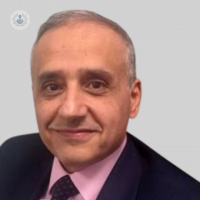Restoring heart rhythm
Escrito por:The human heart is a marvel of biological engineering, with its intricate electrical conduction system responsible for maintaining a steady heartbeat. However, just like any other electrical system, the heart's own wiring can encounter problems over time, leading to slow or irregular heart rhythms. In such cases, a medical marvel known as a pacemaker comes to the rescue, offering a way to overcome these "wiring" faults and restore the heart's rhythm. In his latest online article, Dr Mohamed Al- Obaidi explores the importance of pacemakers in addressing heart rhythm issues and sheds light on the procedure involved in implanting these life-saving devices.

Understanding heart rhythm problems
The heart's electrical conduction system consists of a natural pacemaker and a network of "wiring" (conduction pathways) that ensure synchronised contractions. Over time, this system can degrade, or it may face issues due to injury or damage. When this occurs, the heart's rhythm can become dangerously slow, leading to symptoms such as dizziness, loss of consciousness, or even incidental findings during medical examinations. A pacemaker is an ideal solution to correct these rhythm abnormalities and restore the heart's normal function.
The pacemaker procedure
Implanting a pacemaker is a carefully orchestrated medical procedure. While sedation is available, it is often safer to perform the procedure with the patient awake to monitor their response. Here's an overview of the steps involved:
Local anaesthesia: The procedure typically begins with the operator injecting local anaesthetic under the skin, usually in the upper left or right chest area. Although this may cause initial stinging, it effectively numbs the area and reduces any discomfort throughout the procedure.
Incision and vein selection: Following anaesthesia, a small incision is made. The medical team selects a vein of the ideal size, usually located in the upper chest area. These veins naturally travel back to the heart, making them suitable for introducing the thin and flexible pacing wires.
Pacing wires: Pacemakers designed to address slow heart rhythms require one or two pacing wires, depending on the nature of the conduction problem. These wires are carefully introduced using X-ray guidance. Once inside the heart chambers, they undergo testing, which includes pacing the heart to ensure optimal placement. During this phase, patients may experience sensations like an irregular, skipped, or rapid heartbeat.
Securing the wires: The stability of the pacing wires is crucial. They are secured in the heart using either small wings (tines) or a tiny screw at the tip of the wires. Additionally, stitches are used to secure the wires under the skin after they exit the vein.
Pacemaker placement: The pacing wires are connected to the pacemaker, a small device placed in a pocket created under the skin, typically in the upper chest area.
Closure: Finally, the incision is closed using dissolvable stitches and medical-grade glue to promote healing and minimise scarring.
Pacemakers play a vital role in addressing heart rhythm problems by effectively acting as a backup electrical system for the heart. These life-saving devices are implanted through a carefully orchestrated medical procedure that ensures optimal placement and function. While the process may involve some discomfort and sensation of irregular heartbeats, the benefits of a pacemaker far outweigh the temporary inconveniences. As medical technology continues to advance, pacemakers remain a crucial tool in ensuring cardiac health and enhancing the quality of life for individuals with rhythm disorders.
Dr Mohamed Al-Obaidi is a distinguished cardiologist with over 15 years of experience. You can schedule an appointment with Dr Al-Obaidi on his Top Doctors profile.


